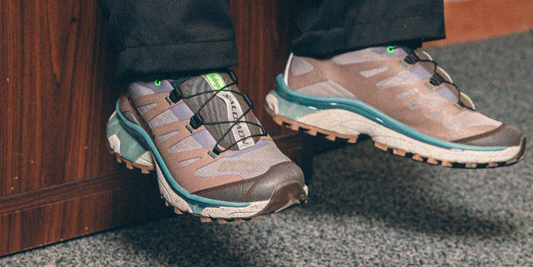Sometimes, when a fact is repeated enough times, it’s easy to just stop thinking about it altogether. That’s why school kids have eternally preferred the multiple-choice question to essays. If you have an exam on, say, the Middle Ages coming up, it’s categorically easier to remember that the Magna Carta was signed in 1215 as an easily digestible factoid, than it is to be faced with an expanse of blank paper, that you are meant to fill with a thorough explanation of why the event in question was important.
 So it goes with the Converse All Star. There is scarcely a mention of the Chuck Taylor that doesn’t include the word icon, or some variation thereof. To be fair, the facts do speak for themselves; the Chuck Taylor has been around for over a hundred years, and has racked up over a billion pairs sold. The shoe is definitely an icon, but leaving the story there feels a lot like filling in ‘B’ and heading over to the cafeteria to beat the long lines.
So it goes with the Converse All Star. There is scarcely a mention of the Chuck Taylor that doesn’t include the word icon, or some variation thereof. To be fair, the facts do speak for themselves; the Chuck Taylor has been around for over a hundred years, and has racked up over a billion pairs sold. The shoe is definitely an icon, but leaving the story there feels a lot like filling in ‘B’ and heading over to the cafeteria to beat the long lines.

For a moment, forget everything you already know about the Chuck Taylor. On a purely surface level, stripped of all context, you have a canvas and vulcanized rubber sneaker that predates the end of World War I. Technologically speaking, a century’s worth of progress has left the All Star in the dust. So what makes this eminently basic design so special? Well, the fact that such a simple design ascended to the status of global icon and cultural institution is actually what makes the shoe special. So, to truly do justice to this icon, we’ll need to take an in-depth look at exactly how a humble basketball shoe took over the world.

Let’s start at the beginning. In the early part of the 20th century, the specialty athletic shoe is still a novel idea, so for a sport in the infancy stages of its development, like the burgeoning game of basketball, to have its own, devoted footwear model went a long way towards establishing the All Star as the basketball shoe. But is anyone in the year 2018 running off to buy a new pair of Chuck Taylors because basketball players not too far removed from playing with actual, wicker peach baskets are wearing All Stars in some grainy, black and white photos? It’s not impossible, but it’s not very likely either. But the chronological age of the All Star is important, as far as establishing the shoe’s historical bona fides and longevity. Look at other, early specialty athletic footwear. It looks primitive enough to have been sported by Fred Flintstone in the “hundred mastodon dash,” or something along those pun-based lines. The Chuck Taylor, some performance tweaks aside, exists in the same form it did during the Wilson administration. But just being around for a long time doesn’t necessarily make something an icon. To make that leap, the Chuck Taylor would have to evolve beyond the sporting purpose that it was designed for.

The post-World War II period of increased prosperity and burgeoning “space age” technology opened a new world of freedom and opportunity for young people that would have been unimaginable just a decade prior. For the first time, youth culture seemed monumental, and entirely distinct from mainstream propriety.

It’s laughable now, but something as quaint as Rock Around the Clock was new and exciting enough to cause actual riots, seen by international audiences, making rock n’ roll an international phenomenon. Naturally, fashion is a critical part of any youth tribe that seeks to carve out its own territory, apart from the cultural mainstream. Before the days when sneakers were a common sight on every street and sidewalk, wearing “gym shoes” as opposed to proper shoes was considered, at best, loutish; no one attempting to appear “respectable” would have worn sneakers as everyday footwear, making them an ideal choice for a youthful, defiant sensibility. With official disapproval in the bag, the always intangible but critically important cool factor was nailed down. Sneakers were established as hip, young and counterculture. Of course, there weren’t thousands of sneaker styles to choose from at the time, so Converse, by far the number one sneaker brand in the country, boasted the most commonly worn sneaker, the Chuck Taylor. Becoming the unofficial shoe of rock n’ roll planted the seeds for the All Star moving from popular shoe to cultural icon, but it would take some time before they would fully bloom. For the time being, the All Star would have to settle for being the default basketball shoe at all levels of the game, which isn’t a bad gig at all, if you can get it.

As the original rock n’ roll movement of the 50s evolved into 60s counterculture and 70s pomp, the prevailing aesthetic changed along with it. In terms of footwear, the classic sneaker gave way to things like sandals, dandyish dress shoes and heavy boots, but the All Star never really went away. It was still a popular sneaker in everyday life, and some of the Chuck loyalists would turn out to be massively influential. The All Star was poised to become the shoe in a world as far removed from the hardwood court as possible. Chuck Taylor himself probably wouldn’t have predicted it, but the shoe he lent his name to would cover every corner of the globe as a subcultural fixture, thanks to the bane of polite society, rock n’ roll.

Rock n’ roll, in all of its forms was running on fumes by the time the late 70s rolled around. The experimentation and openness of 60s counterculture hand wandered down blind alleys marked dour, pompous, complacent and most of all passive, the whole culture had become a rotted edifice, poised to come crashing down with a well placed kick by some sneaker wearing, three chord wielding New Yorkers.

The Ramones were instrumental in defining the punk style, in more ways than one. Not only did their bubblegum buzzsaw assault launch (at least) a thousand bands, their jeans, t-shirts, leather jackets and sneakers look established the punk template that has been mined by style tourists ever since. The All Star actually benefitted from a stroke of good fortune on this front. The Ramones originally sported Keds plimsolls, but when they became unavailable, they switched to Converse. The illustration of a high top All Star wearing Joey Ramone on the cover of the seminal Punk magazine would forever connect the band to the shoe, enshrining it as a subcultural icon.
As an updated, rage filled transfiguration of the original rock form; punk adapted an even more confrontational and defiant version of the wild, teenaged aesthetic. Although punk style was easily pigeonholed as “anti-fashion,” it’s fairly obvious that a great deal of care and effort went into it, which was, in itself, a revolutionary act. Set against the dour, worn-out backdrop of post-hippie convention, where long, un-styled hair, earth tones and loose denim ruled the day. The artfully crafted defiance of the early punks was immediate, visceral and modern, with a suggestion of danger to go along with it.

As the initial wave of punk mutated into the various strains that would become modern, alternative music, the Chuck followed along into every new territory carved out. Aesthetically, the clean, timeless looks obviously made it an ideal footwear choice to keep up with every new style that came along. Culturally, the minimalistic simplicity of the All Star was a marked contrast to the glossy façade and designer obsessed materialism ushered in by the 1980s, making them a permanent fixture in the underground music scene.

When Nirvana became the next big thing with the astounding success of Nevermind in 1991, this culture was let loose in the mainstream all at once. With legions of kids wanting in on this latest youth culture, the All Star’s iconic status was boosted further. When fashion goes beyond the aesthetic, into the realm of self-identification, the clothes and shoes that a person wears are a message to anyone seeing them. Chuck Taylors didn’t just say something about what you liked, they said something about what you are like.
Then there’s the flip side to all this. Frankly, it’s a much shorter story. You don’t sell a billion pairs of anything by solely being associated with any specific cultural niche. Countless pairs of Chucks have been sold to people who really did just want a simple pair of sneakers that compliments any outfit. But that doesn’t negate the story; it completes it. How many shoes are there that pair as perfectly with khakis and a plain, V-neck sweater as they do with a studded jacket and ripped jeans? What makes the Chuck Taylor the ultimate icon? It has transcended time and place thanks to its ability to be all things to all people.
Pairing up with the design world’s superstar of the moment, Virgil Abloh and his Off White imprint should come as no surprise; it’s a natural fit. As opposed to some of the technologically advanced models that Abloh has worked with, that had to be bent to Off White’s will, a collaborative variant of the All Star is just another reinvention. What better way to showcase the versatility Off White’s deconstructed utilitarianism than to seamlessly apply it to the most timeless silhouette ever?









